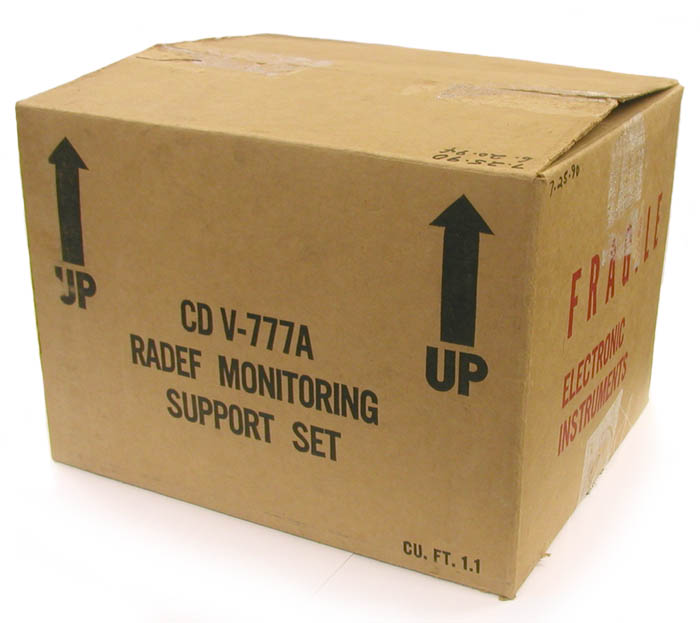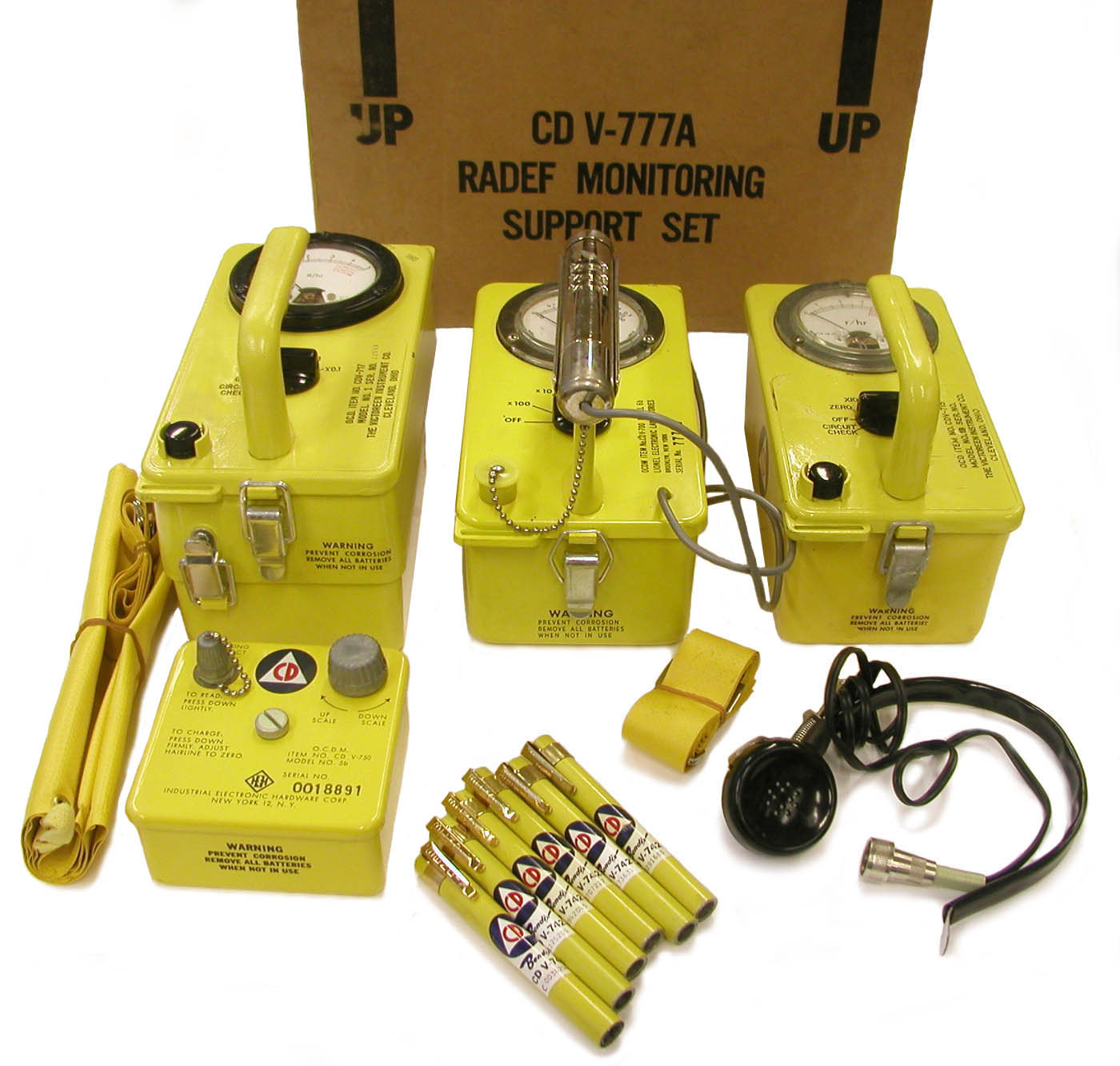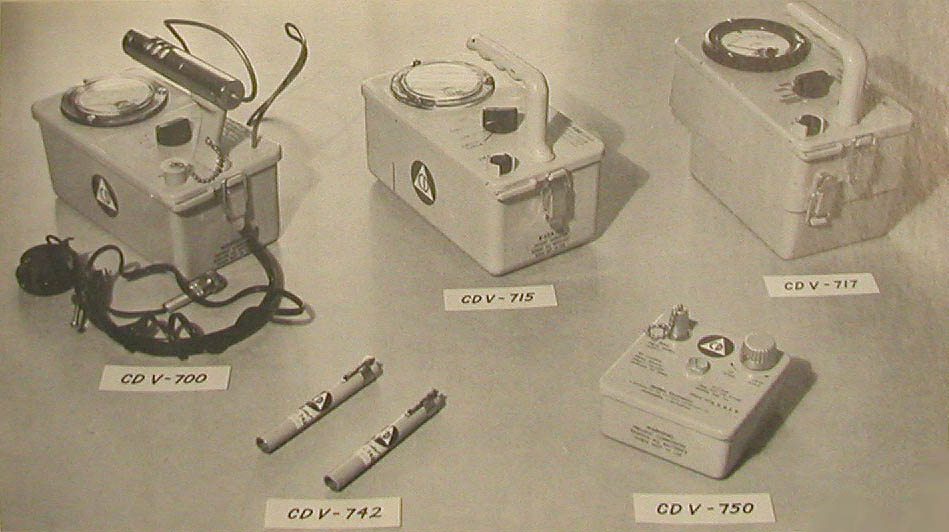CD V-777A Kit for Surface Monitoring and Reporting Stations
For additional information about the various CD V-777 sets, go to the General Information section.
The 1991 FEMA publication Use of Civil Defense Radiological Instruments for Peacetime Radiological Emergencies (CPG 2-2) states that the recommended composition of the CD V-777A "RADEF Monitoring Support Set" is: one CD V-700 GM detector, one CD V-715 ion chamber, one CD V-717 ion chamber, six CD V-742 pocket dosimeters and one CD V-750 charger. Instrument sets issued prior to 1978 included two dosimeters rather than six according to the Defense Civil Preparedness Agency's Radiological Defense Preparedness (CPG 2-6.1). Note that the CD V-777A is the only set that includes the CD V-717.

Size: 12" x 14" x 10"
CPG 2-2 also states that "The CD V-777A set is the standard set recommended for surface monitoring and reporting stations." CPG 2-6.1, says exactly the same thing.
Quoting CPG 1-30 (FEMA 1981): "This set is issued in the WER station. One set is needed for each WER station established in the community." The term "WER" refers to the Weapons Effects Reporting stations which had previously been referred to as Fallout Monitoring or Fixed Monitoring stations. According to CPG 1-30, they are facilities with fallout protection, reliable communications, instruments and trained monitors that are designated for the collection and reporting of weapons effects and radiological data to the Emergency Operating Center (EOC).
When it was first issued, the CD V-777A was simply intended to expand the capabilities of selected monitoring stations—the CD V-777 continued to serve as the stations' primary operational set. Quoting the OCD's Annual Report for 1965, "Late in fiscal year 1965, additional radiological defense equipment, monitoring support set CD V-777A, was made available to selected monitoring stations. This support set includes a remote reading, high range survey meter that permits radiation measurements to be taken at a distance of 25 feet, lessening the exposure hazard to monitors operating in areas of high radiation intensity. The set also increased the availability of radiological instruments to stations responsible for extensive mobile or aerial support operations."
By 1978, when Radiological Defense Preparedness (CPG 2-6.1) was published, the CD V-777A had become the only operational monitoring set while the CD V-777 had been designated "for emergency service and vital facility self-protection monitoring."

The survey instruments in the above photograph are (from left to right): the CD V-717, the CD V-700 and the CD V-715. Just to the left of the CD V-717 is a yellow vinyl bag that is used to protect the latter's removable ion chamber when it is located outside the station/shelter. It can protect the chamber from the elements as well as from fallout.
The following text from CPG 1-30 Guide for the Design and Development of a Local Radiological Defense Support System (1981) nicely summarizes the capabilities that the CD V-777A would provide the monitoring (Weapons Effects Reporting) stations:
"Monitoring, Reporting and Assessment Capability—for determining the extent and magnitude of the radiological hazard in a jurisdiction. This capability is necessary to provide decision-makers with information on:
- When and where weapons have been detonated
- When fallout arrives
- The extent and severity of fallout radiation
Using this and other information, the decision maker may then consider:
- If and when emergency operations can be initiated
- When people may emerge from shelters
- When restrictions in shelter living may be relaxed
- When decontamination or other countermeasures should be undertaken
It is necessary to establish a network of Weapons Effects Reporting (WER) stations to report:
- Sightings of nuclear detonations (by time and direction)
- Observed damage, such as glass breakage or structural damage, in the vicinity of the station
- Arrival and subsequent fallout radiation levels
These reports are made to the Emergency Operating Center which is responsible for:
- Processing, displaying, and analyzing the weapons effects information
- Supplementing the routine data by special query when data are missing
- Providing data on the radiation environment to the decision-makers in the EOC
- Providing simplified summaries of the status of the radiological hazards for the general public
- Providing summaries of the local radiological situation to higher governments and other communities in accordance with agreed procedures"
The following figure from the 1966 Annual Report of the OCD shows the first version of the CD V-777A set.

CD V-777 set donated by the State of Wisconsin courtesy of Michael Mack.
References
- Defense Civil Preparedness Agency. Radiological Defense Preparedness. CPG 2-6.1. April 1978.
- Federal Emergency Management Agency. Guide for the Design and Development of a Local Radiological Defense Support System. CPG 1-30. June 1981.
- Federal Emergency Management Agency. Use of Civil Defense Radiological Instruments for Peacetime Radiological Emergencies. CPG 2-2. 1991.
